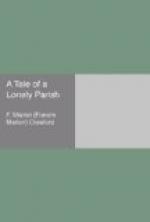“Really, Angleside”, he would say, “I believe I could throw straighter myself. I’m quite sure Carlo can get her out if you leave him alone”.
Whereupon Cornelius would put his hands in his pockets and look on, and in a few minutes, when the cat had been driven out and the vicar’s back was turned, he would slip a sixpence into old Reynold’s hand, and follow his tutor reluctantly back to the study. Whether there was any connection between the cat and the sixpence is uncertain, but during the last months of Angleside’s stay at the vicarage the ingenuity of Simon Gunn’s yellow cat in getting over the wire netting reached such a pitch that the vicar began to prepare a letter to the Bishop Stortford Chronicle on the relations generally existing between cats and asparagus beds.
Another event in the life of the vicarage was the periodical lameness of the vicar’s strawberry mare, followed by the invariable discovery that George Horsnell the village blacksmith had run a nail into her foot when he shoed her last. Invariably, also, the vicar threatened that in future the mare should be shod by Hawkins the rival blacksmith, who was a dissenter and had consequently never been employed by the vicarage. Moreover it was generally rumoured once every year that old Nat Barker, the octogenarian cripple who had not been able to stand upon his feet for twenty years, was at the point of death. He invariably recovered, however, in time to put in an appearance by proxy at the distribution of a certain dole of a loaf and a shilling on boxing day. It was told also that in remote times the Puckeridge hounds had once come that way and that the fox had got into the churchyard. A repetition of this stirring event was anxiously looked for during many years, every time that the said pack met within ten miles of Billingsfield, but hitherto it had been looked for in vain. On the whole the life at the vicarage was not eventful, and the studies of the two young men who imbibed learning at the feet of the Reverend Augustin Ambrose were rarely interrupted.
Mrs. Ambrose herself represented the feminine element in the society of the little place. The new doctor was a strange man, suspected of being a free-thinker, and he was not married. The Hall, for there was a Hall at Billingsfield, was uninhabited, and had been uninhabited for years. The estate which belonged to it was unimportant and moreover was in Chancery and seemed likely to stay there, for reasons no one ever mentioned at Billingsfield, because no one knew anything about them. From time to time a legal looking personage drove up to the Duke’s Head, which was kept by Mr. Abraham Boosey, who was also undertaker to the parish, and which was thought to be a very good inn. The legal personage stayed a day or two, spending most of his time at the Hall and in driving about to the scattered farms which represented the estate, but he never came to the vicarage, nor did the vicar ever seem to know what he was doing




